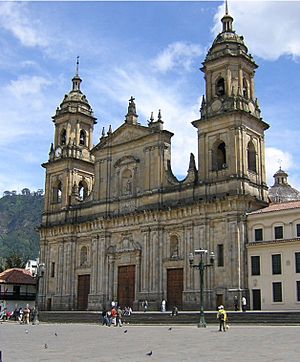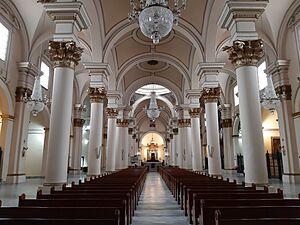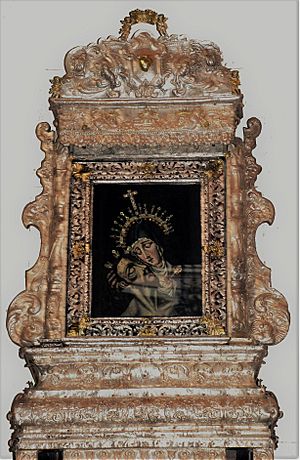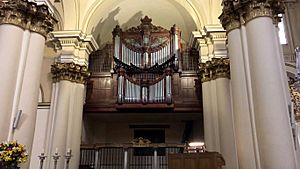Primatial Cathedral of Bogotá facts for kids
Quick facts for kids Cathedral Basilica Metropolitan & Primatial of the Immaculate Conception & Saint Peter of Bogotá |
|
|---|---|
|
Catedral Basílica Metropolitana y Primada de la Inmaculada Concepción y San Pedro de Bogotá
|
|

Bogotá Metropolitan Basilica Cathedral next to Sacred Chapel and Archiepiscopal Palace
|
|
| Religion | |
| Affiliation | Roman Catholic |
| District | Archdiocese of Bogotá |
| Ecclesiastical or organizational status | Cathedral, Minor basilica |
| Leadership | Archbishop Metropolitan of Bogotá Luis José Rueda Aparicio |
| Location | |
| Location | Bogotá, Colombia |
| Architecture | |
| Architect(s) | Friar Domingo de Petrés |
| Architectural type | Church |
| Architectural style | Neoclassical |
| Groundbreaking | 1807 (fourth cathedral) |
| Completed | 1823 |
| Specifications | |
| Direction of façade | West |
| Height (max) | 52 |
| Website | |
| http://catedral.arquibogota.org.co/es/ | |
The Metropolitan Cathedral Basilica of Bogotá is a very important Catholic church in Bogotá, the capital city of Colombia. It's officially called the Sacred Holy Temple Metropolitan Cathedral Basilica and Primate of the Immaculate Conception of Mary and Saint Peter. This beautiful building is dedicated to the Immaculate Conception and Saint Peter.
You can find this Neoclassical style church in the main square of Bogotá, called Plaza de Bolívar. It's the main church for the Archbishop of Bogotá. In 1902, Pope Leo XIII gave it the special title of Primate of Colombia. This means it's the most important Catholic church in the country.
The cathedral was designed by Domingo de Petrés. It was built between 1807 and 1823. Before this one, three other churches stood in the same spot. Because of its long history and beautiful design, it was named a National Monument in 1975.
Contents
History of the Bogotá Cathedral
Early Churches and Beginnings
The story of the cathedral began on August 6, 1538. Spanish explorers arrived in the Bogotá savanna. A missionary named Friar Domingo de las Casas held the first Mass there. It was in a simple chapel made of mud and straw. This was the very spot where the first stones for a church were later placed. The Spanish called the place "Nuestra Señora de la Esperanza."
In 1553, a decision was made to build a bigger cathedral. Friar Juan de los Barrios led this effort. It was planned to have mud and brick walls. The work started, but in 1560, the roof collapsed just before it was finished. Even so, Pope Pius IV still gave it the title of Cathedral in 1562.
Building the Second and Third Cathedrals
Twelve years later, Friar Juan de los Barrios, who became the first archbishop, helped start a new cathedral. He carried the first stone himself to inspire others. Construction began on March 12, 1572. This new church had three main sections and four chapels.
The main parts of this third church were finished by 1590. The tower was completed in 1678. This cathedral was known for its rich services and music. However, a big earthquake hit Bogotá on July 12, 1785. It badly damaged the building. So, in 1805, parts of it had to be taken down.
The Current Cathedral's Construction
In the early 1800s, Friar Domingo de Petrés was chosen to rebuild the cathedral. He was a Capuchin friar and a skilled architect. He was inspired by the Neoclassical style, which was popular then. Friar Domingo started the work on the new cathedral on February 11, 1807. He is known as one of the most important architects in the region's history. He also designed other famous buildings.
Friar Domingo passed away in 1811. By then, the inside of the cathedral was mostly done. Nicolás León took over and finished the rest of the work. The cathedral was finally completed on April 19, 1823. It was officially blessed that same year. In 1902, Pope Leo XIII gave it the special title of Primate of Colombia.
Location and Surroundings
The Cathedral's Place in Bogotá
The Metropolitan Cathedral Basilica is located on the eastern side of Plaza de Bolívar. This is in the historic center of Bogotá, in an area called La Candelaria. The main entrance faces west, looking out onto Plaza de Bolívar. A side door faces north, towards the Museum of the 20 de julio.
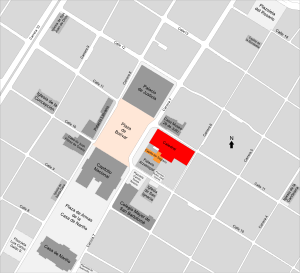
Buildings Around the Cathedral
Right next to the cathedral, on its south side, is the Chapel del Sagrario. This is another church built between 1660 and 1689. Between the Cathedral and the Chapel del Sagrario is the Casa del Cabildo Eclesiástico. This three-story building was built in 1689.
The Archbishop's Palace completes the block on Plaza de Bolívar. This building was constructed between 1952 and 1959. It replaced an older palace that was destroyed in 1948.
The Plaza de Bolívar itself is a very important place. It has been the site of many major events in Colombia's history. Other important buildings around the square include the Palace of Justice, the Palacio Liévano (Bogotá's Mayor's Office), and the Capitolio Nacional. In the center of the square, there is a statue of Simón Bolívar, which was placed there in 1847.
Cathedral Design and Features
Layout and Interior
The cathedral has a classic church design, shaped like a Latin cross. It covers a large area of about 5,300 square meters. Inside, it has five main sections called naves. The central nave and two side naves are tall. The other two naves hold chapels.
There is a main altar and 16 chapels. Eight chapels are on the south side, eight on the north side, and one at the front of the central nave. The inside walls and ceilings are white. The ceilings have decorative designs in the center.
Exterior Details
The front of the cathedral, called the portal, has two main parts. The first part has eight tall, decorative columns. The second part also has columns. Three sculptures by Juan de Cabrera are above the doors. Saint Peter is above the north door, Saint Paul is above the south door, and the Immaculate Conception is above the main front door.
The towers of the cathedral are 52 meters (about 170 feet) high. They were rebuilt after an earthquake in 1827. Each tower has three sections with openings for bells. The south tower is dedicated to Saint Barbara. The north tower, dedicated to Saint Emygdius, has a clock.
The main door is very old, made in the 16th century. It is about 7.2 meters (23.6 feet) tall and 3.6 meters (11.8 feet) wide. It has decorative columns and metal fittings. The side doors are a bit smaller. The open area in front of the cathedral, called the atrium, is 110 meters (360 feet) long. It was built between 1631 and 1664.
Important Chapels
Chapel of the Baptistery
When you enter the cathedral on the right side, you'll find the Chapel of the Baptistery. It has a stone baptismal font from the 18th century. Behind it is a painting called "Baptism of Christ" from 1898.
Chapel of Saint Elizabeth of Hungary
This chapel is dedicated to Saint Elizabeth of Hungary, who is the patron saint of the Archdiocese of Bogotá. A famous painting of "Saint Elizabeth of Hungary" is here.

This chapel is special because it holds the tomb of Gonzalo Jiménez de Quesada. He was a Spanish conquistador and the founder of Bogotá. His tomb was sculpted by Luis Alberto Acuña. Also, the remains of General Antonio Nariño are here.
Chapel of Saint James the Apostle
This chapel features an altar with a colonial painting called "Saint James Apostle in the Battle of Clavijo." This painting was created by Gregorio Vásquez de Arce y Ceballos. The painter himself, Gregorio Vásquez de Arce y Ceballos (1638–1711), is buried in this very chapel.
Chapel of Our Lady of El Topo
Behind the main altar is the Chapel of Our Lady of El Topo. This chapel is a historical and religious treasure. It has an altar from the 18th century. The main painting, from 1610, shows Our Lady of Sorrows of El Topo. This painting is very old and has been honored in the cathedral since 1610.
Chapel of the Immaculate Conception
This chapel is dedicated to the Immaculate Conception, who is the patron saint of Bogotá. It has a statue of the Immaculate Conception, placed there in 1904. There is also a statue over the tomb of Archbishop Bernardo Herrera Restrepo.
Chapel of Saint Joseph
This is the oldest chapel in the cathedral, built in 1590. It has an altar and a statue of the Virgin of Mercy.
The Pipe Organ
The cathedral has a very large pipe organ. It was built by Aquilino Amezua, a famous Spanish organ maker. This organ has 58 different sounds, four keyboards for the hands, and a keyboard for the feet. It has about 4,500 pipes, making it the biggest organ in Colombia. It can sound like many different instruments, such as trumpets, oboes, flutes, and even human voices. It is used for religious services and also for concerts.
The organ was restored between 2013 and 2016. This big project cost over 2.5 billion Colombian pesos. The restoration was done by a Spanish company that has worked on organs in other famous cathedrals. The organ was officially reopened on July 2, 2016, with a special blessing and a concert.
Other Burials
Many important people are buried at the Primatial Cathedral of Bogotá. Some of them include:
- Aníbal Muñoz Duque
- Aurelio París Sanz de Santamaría
- Julián de Cortázar
- Policarpa Salavarrieta (a memorial, not her actual remains)
Geography and Parish Boundaries
The cathedral's parish boundaries are:
- North: Church of La Veracruz and Church of Nuestra Señora de Las Aguas
- South: Nuestra Señora de Belén and Santa Bárbara Parishes (Center)
- East: Church of Nuestra Señora de Egipto
- West: Church of La Capuchina.
See also
 In Spanish: Catedral primada de Colombia para niños
In Spanish: Catedral primada de Colombia para niños
- List of buildings in Bogotá
- List of tallest structures built before the 20th century


